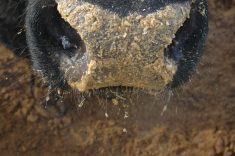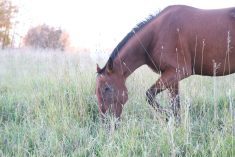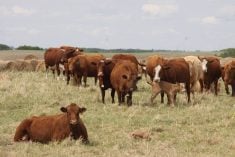New technologies also need an on-farm benefit, and some winners are showing up that help efficiency and profitability
When researchers reached the end of their triels of 3-nitrooxypropanol, a feed additive that reduces methane emissions, they also expected to see an increase in feed efficiency in the cattle that consumed it. They didn’t.
Without a feed efficiency improvement, the adoption route for 3-NOP, known by its commercial name Bovaer, became more challenging.
“The number one that would really open things up would be that if the additive resulted in a reduction in methane emissions that had a corresponding improvement in feed efficiency so that it took less feed to produce the same amount of meat or milk,” says Tim McAllister, principal research scientist for cattle production with Agriculture Canada’s research centre in Lethbridge.
Read Also

Canada’s slaughter horse industry lacks transparency
The lack of clear reporting and public access to data keeps the industry largely hidden, leaving questions about humane treatment and traceability unanswered.
“That would kind of be a no-brainer, and a pretty major economic incentive.”
The 3-NOP example is a good illustration of the challenge facing the growing number of technologies to lower methane production: the technologies that will win show an easy gain for farmers.
Growth in the use of corn with the Enogen gene in North America is a good example. Farmers use it because it makes their beef and dairy cattle more feed efficient by about five per cent, according to University of Nebraska and Kansas State University studies.
That improvement in feed efficiency also means fewer methane emissions per animal, and that’s attracted the interest of companies such as McDonald’s, which recently announced an incentive in the United States for beef farmers using Enogen corn. Farmers will have to do some paperwork to qualify and report.
Enogen requires little change to a current production system, which makes its adoption more likely.
There are several ways to make these technologies make sense, including an incentive from a government, a market payment from a buyer or a carbon credit market, or because the technology makes the farm more efficient or profitable.
Canadian cattle and dairy farmers already have lower greenhouse gas emissions per unit than most other countries due to their ability to breed, manage and feed cattle for higher performance.
McAllister says there are still improvements to be made in nutrition and management. Those decisions would make a farm more efficient through faster time to market or less feed used.
Dairy Farmers of Canada has produced a guide with best management practices for the reduction of methane to try to encourage broader adoption of farm practices that make a difference.
The cattle industry has historically used supplements to make cattle more efficient. Ionophores such as Rumensin stabilize cattle rumens and decrease their time to market. Beta-agonists such as ractopamine have a different function but also improve cattle lean gain. These also reduce the volume of methane emissions.
Researchers continue to put significant resources into understanding rumen processes with the hope of a double win for methane reduction and farm efficiency.
Other compounds similar to 3-NOP also act to manage methanogens in the rumen and help reduce methane emissions, says McAllister.
The failure to find an expected link between 3-NOP and feed efficiency has sent researchers back to basics on rumen function.
“All of the stoichiometric equations that we would use to predict energy flow would have predicted that we would have seen that value in the animal, and we’re very perplexed as to why we haven’t seen that,” he says.
The answer is likely tied to the flow of hydrogen in the rumen, he adds.
More work is needed to make 3-NOP and similar additives useful to the large number of cattle that spend their time on rangelands. The 3-NOP requires daily addition to feed, which might work in a feedlot but not in a pasture.
Agriculture Canada researchers have also looked at feeding seaweed to cattle.
Research biologist John Duynisveld worked with Dr. Ghader Manafiazar from the Dalhousie University Agriculture Campus to study feeding kelp to cattle to reduce methane emissions.
Similar to 3-NOP, researchers found that it reduced methane emissions by 11 to 15 per cent, according to Agriculture Canada.
It also showed no effect on feed intake and growth rate. More data is being evaluated and will be released in the future, but there are cost and scalability challenges if seaweed is to make sense on farms.
Technologies without an on-farm efficiency benefit will need an incentive from a government or a carbon marketplace.
In Europe, several projects by either dairy processing companies or governments pay for the use of methane-reducing additives, such as 3-NOP. However, there’s been an online backlash against the feed additive in Europe from a mix of anti-climate change sentiment and a sprinkling of European precautionary principle thinking.
It’s challenging to make carbon markets work efficiently on farms because of the amount of data collection required and a lack of stability in the markets. However, they could also be a way for farmers to receive funds for making changes to manage methane.
Korb Whale, an Ontario dairy farmer with a biogas digester, works with other farms with digesters to receive carbon credit payments. They find it challenging to collect data and find third party services that don’t cost too much to help manage the system.
McAllister says Alberta already has offset programs in place to reduce time to slaughter, and they will likely financially reward the use of additives.
He says if an additive’s manufacturer tries to capture all of the carbon credit, the farmer will be left with little incentive to pay for the additive.
“If you have aggregators and multiple different people involved in that process, they can end up taking quite a bit of the value that comes out of the carbon credits to pay for their contribution,” says McAllister.
In the case of Enogen corn, Syngenta will pay farmers the incentive from McDonald’s, but McDonald’s will be the end recipient of the carbon credit. However, no other organizations take a cut out of the process.
That’s why Nicole Sillett, director of sustainability and on-farm services with Dairy Farmers of Canada, suggested at a recent University of Guelph research event that the carbon credit aggregator role could be taken on by a farm organization.
“‘If I’ve learned anything about carbon markets, it’s that they’re complex and confusing,” she said.
One reason Canadian cattle are already more methane efficient than those in the rest of the world is the focus on genetic improvement.
However, while feed efficiency is heritable, the beef and dairy sectors haven’t focused on it the way it is in swine and poultry.
Selection for methane efficiency is lowly heritable, says McAllister, and he cautioned that selecting for one trait can mean an unintended consequence by reducing another important trait.
Genetic improvement can also be slow.
The Canadian dairy sector now has a methane index as part of its genetic selection options, and it will be integrated into the overall Lifetime Profit Index next year, which should produce a gradual improvement over time.
The beef sector has been slower in moving in this direction, but that’s changing.
“We haven’t really tapped into the role genetics can play, and genetic selection decisions can play, in sustainable production and how that can reduce our environmental footprint in the industry,” says Sandy Russell, chief executive officer of the Canadian Beef Breeds Council.
She says knowing the 10 per cent most inefficient animals on beef farms is a good place to start. Eliminating them, whether that’s based on feed efficiency, weaning weights or another production measure, will improve on-farm efficiency and could also affect methane emissions.
However, Russell says there’s a need to better drive the information down the value chain so that the cow-calf producer can have the necessary information to make the decisions on which animal is least efficient.
There’s fatigue in the farming community around sustainability, but solutions to environmental problems, including methane, can also include improvements in farm efficiency and profitability, and that’s where the big wins will come.


















